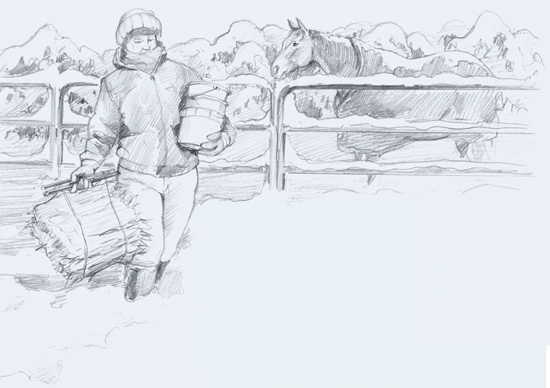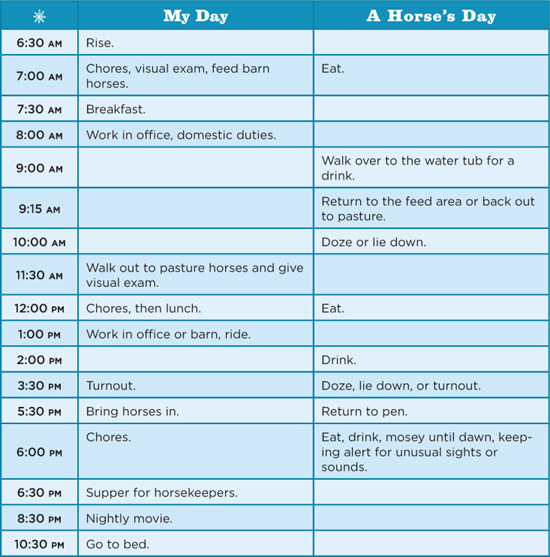

Some of our winters are so mild that we can ride all season. Others have such steady, strong winds and cold temperatures that it makes sense just to work on indoor projects. Often, therefore, at this time of year we are simply horsekeepers — feeding, scooping, and providing veterinary and farrier care. These tasks are not only necessary but, to me, they are also deeply satisfying.
This season usually marks the beginning of a slow-down. Even though the cold days and long nights might allow us a bit more R&R, our horses need as much care, if not more, during the winter. Although some horses might still be out on pasture full time (depending on the year and pasture condition), we have been carrying hay and grain out to them, twice a day, for some time now. Some horses are in pens with turnout for exercise only.
Weekly Tasks
 Restock the hay supply in horse barns
Restock the hay supply in horse barns
 Check grain supply
Check grain supply
 Check bedding supply
Check bedding supply
 Dump and scrub all waterers, troughs, tanks, tubs, and buckets
Dump and scrub all waterers, troughs, tanks, tubs, and buckets
 Scrub feed dishes
Scrub feed dishes
 Check veterinary supply needs
Check veterinary supply needs
 Check upcoming farrier and veterinarian appointments and prepare for them
Check upcoming farrier and veterinarian appointments and prepare for them
Seasonal Tasks
 Make winter shoeing plans
Make winter shoeing plans
 Monitor winter water intake
Monitor winter water intake
 Increase roughage when below freezing
Increase roughage when below freezing
 Keep winter feeding areas clean of old feed
Keep winter feeding areas clean of old feed
 Spread manure
Spread manure
 Clean tack and get ready for spring!
Clean tack and get ready for spring!
 Monitor pastures daily
Monitor pastures daily
 Remove horses from pasture while there is still vegetation in the field
Remove horses from pasture while there is still vegetation in the field
During the winter it is necessary to keep a close eye out for signs of wood chewing, because horses that have been used to unlimited pasture turnout and are confined during wet, cold weather are the most likely candidates for this vice. An anti-chew kit is kept at the ready to treat freshly chewed wood the moment it is spotted. I increase the feed that the barn horses receive at their three meals because the nutrition that they receive from short pasture turnout is minimal.
Because there are still horses on pasture, I go out to check them at least once a day with my Pasture Kit. I often do this just before lunch. Our horses might be wearing sheets or blankets or they might be au naturel, with fluffy winter coats, depending on our plans for them for the winter.
OVERALL STANCE AND ATTITUDE. As I approach the barn, does the horse have his head up, are his eyes bright, and is he eager for feed, or is he lethargic, inattentive, or pacing and shivering?
LEGS. I look at the horse from both sides to quickly spot any wounds, swelling, or puffiness. With winter hair, I might have to feel for any abnormalities.
APPETITE. Has the horse finished all of his feed from the previous feeding? I keep track of winter weight with a rib check (see November Feed Bag).
WATER. Is there evidence that he has taken in a sufficient amount of water?
MANURE. Is the fecal material well formed, or hard and dry, loose and sloppy, covered with mucus or parasites, or filled with whole grains? Are there at least three manure piles since I last fed the horse?
PEN, SHELTER, OR STALL. Are there signs of pawing, rubbing, rolling, thrashing, or wood chewing?
BLANKET. If the horse is wearing a blanket, I check underneath for heat or signs of past sweating and check that all straps are fastened and the blanket is properly positioned. I also feel his ribs and check if the blanket has been rubbing off any hair, especially at the shoulders and withers.
